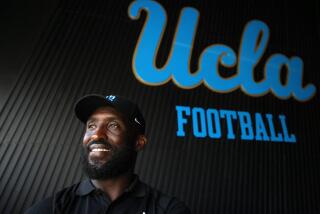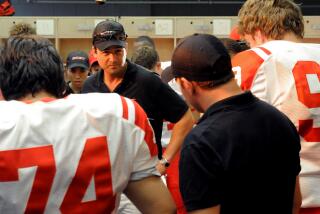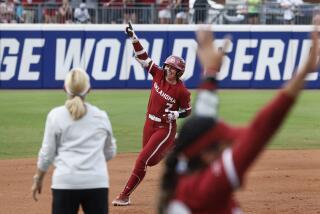Power Builders
NORMAN, Okla. — Maybe they ought to hang a banner in the quad that reads: “Men (and Women!) at Work.” Everywhere you look, people are kicking up dust, setting out orange cones, cordoning off areas, moving boxes and waiting for the lunch whistle to blow.
Welcome to the Reconstruction.
At Memorial Stadium, men in hardhats bang hammers and lay steel reinforcing rods as work continues on an 8,000-seat expansion project.
At the nearby intramural fields, the Oklahoma football hardhats lay the cornerstone for another championship season.
Aides with stop watches record the 40-yard-dash times and report to Coach Bob Stoops, who reports to his players, “No question, this is the fastest team we’ve had.”
As laborers labor, and bulldozers roar, kids watch their football heroes from afar, clinging to chain-link fencing.
There is no Boz anymore in Norman, yet there remains a buzz.
The Sooner defense, led by defensive end Tommie Harris, is track-team fast, and the offense has been revamped, along with just about everything else on campus.
The schedule breaks downwind. After tonight’s opener at Tulsa, the Sooners have scandal-plagued and scholarship-challenged Alabama visiting Norman on Sept. 7 and archrival Nebraska off the schedule this season.
There is the annual Red River Shootout against Texas in Dallas on Oct. 12, potentially the game of the year in college football, yet when hasn’t Oklahoma defeated Texas lately in a game that counts?
Colorado will be a handful on Nov. 2, but the Buffaloes have to come to Norman.
Oklahoma is No. 1 in this and several other preseason publications, and if you believe what Will Rogers said, “All I know is just what I read in the papers,” Oklahoma is headed for another national title game appearance in this year’s Fiesta Bowl.
Former Sooner option quarterback J.C. Watts, the outgoing United States congressman--he has elected not to seek another term--watched a recent practice with renewed political interest.
During low ebb in the late 1990s, when Oklahoma football suffered its worst four-year stretch under former coach John Blake, Watts rarely joined sporting conversation with his political peers.
“I dodged the cloak room for two or three years,” Watts said with a laugh. “You know, the men of Congress have their teams. You go to the floor and talk about your teams. And here I am saying, ‘God, I’ll be glad when basketball comes around.’ ”
Not that many years removed from when Oklahoma bore the face of just another big-time, low-scrupled, win-at-all cost program destined for NCAA probation, its players running amok, the university is in the midst of an astounding renewal.
Somewhere between recklessness and renaissance, Oklahoma conjured the audacious idea that it wanted to become a jewel in the crown of colleges.
Oklahoma had the gall to think it could become a landlocked Stanford, with lower property values.
“There’s nothing wrong with using that as a benchmark,” Athletic Director Joe Castiglione said.
Reminded that Stanford was a tad better situated, geographically and academically, Castiglione added, “We recognize our limitations.”
Norman, as a town, isn’t the prettiest cowgirl to look at, when you consider its wayward winds and flat landscape, yet that hasn’t stopped the Oklahoma Earth Movers.
Last year, Oklahoma football finished 11-2 and was ranked sixth, only a couple of bounces shy of reaching its second consecutive bowl championship series title game.
The men’s and women’s basketball team made the Final Four, Kelvin Sampson’s squad losing in the national semifinals to Indiana while Sherri Coale’s women were defeated by Connecticut in the title game.
Oklahoma notes that 2001 was the first time a school’s football team won 11 games the same season its men’s and women’s basketball squads won more than 30 games.
Borrowing from basketball’s statistical line, the triple-double, the Sooners are calling their feat a 10-30-30.
To boot, Oklahoma won the national title in men’s gymnastics and finished third in wrestling.
Like any development plan, Oklahoma’s rise has come in stages.
Phase I was the 1994 push-start that came from incoming school president David Boren, the former Oklahoma governor and United States senator, who upped the educational ante with a $500-million fund-raising drive to improve all aspects of campus life.
Phase II kicked in four years ago, with the hiring of Castiglione as athletic director.
Castiglione, who came from Missouri, oversaw all sports, but realized Oklahoma football floated all boats. It was he who recommended Blake be fired and he who identified, sought out and ultimately hired defensive coordinator Bob Stoops from Steve Spurrier’s staff at Florida.
Most thought Stoops was destined to succeed Hayden Fry at Iowa, his alma mater, but Iowa administrators fumbled the negotiations and Stoops landed on Castiglione’s stoop.
“I worked hard not to get left at the altar,” Castiglione said.
Two years later, in 2000, Oklahoma went undefeated, claiming its seventh national championship.
Behind the scenes, Castiglione was patching up the rest of the department.
He was astonished to discover, when he took over, that there were people in the athletic department who had never met.
Basketball Coach Sampson said Castiglione has brought such closeness to the department, “I swear we’re going to break out a campfire, roast marshmallows and sing ‘Kumbaya.’ ”
A prominent Division I football coach once said it was nearly impossible to have great football and basketball programs at the same school because of the friction and egos involved, not to mention the competition for money.
Castiglione convinced his other coaches that, with football leading the financial way, all Oklahoma sports could prosper.
“Oklahomans need football to do well,” Sampson said. “They need it from a health standpoint.”
Sure enough, with football back on top, donations started to pour in. Happy donors are generous donors. The athletic department recently passed the $83-million dollar mark in an ambitious $100-million money-raising campaign.
Oklahoma wasn’t immune from tension between departments.
Sampson’s basketball squad had been top-notched for years, yet found it difficult getting court time in its own gym.
Coale, the women’s coach, said the only way her players could get court time was to play challenge court against other students in the campus gym.
“For a while,” Coale said of her squad, “they weren’t good enough.”
Castiglione preached patience and told his coaches not to be satisfied with a short-term fix. Sampson and Coale have since been rewarded with identical lavish practice facilities built adjacent the Lloyd Noble Center.
What more could Coale want?
“I could use a post player,” she said.
Buck stops with Stoops
Oklahoma’s resurgence would not have been possible without football or without Stoops, who turns 42 on Sept. 9.
This was Phase III.
Some coaches at big-time football schools prefer to isolate their program from others in the department. Stoops ran a different route.
“Bob Stoops is the key player in this whole thing,” Coale said. “He’s telling everyone, ‘Not only is it OK for you to be successful, we want you to be successful.’ ”
Stoops makes it a point to visit all softball recruits who come to visit, and has been seen more than once on the first tee, whooping it up for the women’s golf team.
Stoops was the first to shake Sampson’s hand when the team returned home after winning last year’s West Regional final.
Stoops has heard stories about football and basketball coaches who don’t get along.
“The ones who say it can’t be done, well, it’s a cop-out,” Stoops said. “I wouldn’t doubt that it happens in some places, but it doesn’t have to be a battle and here, it sure isn’t.”
Sampson and Stoops have become close friends and allies. Sampson plans basketball-recruiting visits around football games. If the football team is good, it helps basketball.
“Basketball doesn’t need to be the flagship program here,” Sampson said. “We can be part of the solution, we can’t be the solution.”
Sampson took some sage advice on the subject from Bob Knight.
“Don’t fight football,” Knight told him.
Coale knew as much, having grown up in Oklahoma with a house full of devoted Sooner fans. Her upbringing was as straightforward as a fullback belly dive.
“You worshipped the football gods at OU,” she said.
Trent Smith, Oklahoma’s star senior tight end, could tell you about the gravity pull.
Smith was born in Norman and dreamed of becoming a Sooner, no matter the state of the program.
“I kept waiting for one letter, the Oklahoma letter,” Smith said of his recruitment process.
Smith was recruited by Blake when the program was in the tank.
It didn’t matter.
Smith confesses to having taken a recruiting trip to Notre Dame, but says it was a token visit.
In fact, Smith said, “I sent Coach Blake a postcard from South Bend.”
Stoops has rebuilt Sooner football, with mortar and brick.
Oklahoma had gone 12-22 in the three years before he took over. In Stoops’ first three seasons, Oklahoma is 31-7 with a national championship.
Stoops is more like Bud Wilkinson than Barry Switzer, each of whom coached the Sooners to three national titles. Wilkinson was a straight-arrow who helped ease the state’s collective malaise in the aftermath of the Dust Bowl exodus.
Switzer won ridiculously often too, yet he ran his team the way an Old West bartender might have run his saloon.
Stoops is no bootlegger’s son.
He is a blue-collar product of Youngstown, Ohio, the kind of place Bruce Springsteen sings about.
Stoops learned tenacity and discipline as defensive coordinator at Kansas State under Bill Snyder, and untold intangibles in three years as coordinator under Spurrier in Gainesville.
“He changed me in a huge way,” Stoops said of Spurrier, now coaching the Washington Redskins. “He taught me to be balanced and, he taught me to embrace the competition.”
The week of Oklahoma’s national title game against Florida State in the 2001 Orange Bowl, Stoops came off as aloof, almost cocky, in his press-conference statements.
He says now he was just confident, that’s all, pointing out that Florida State had never defeated Oklahoma in football.
Still hasn’t.
“There was no way we were going to lose,” Stoops said. Oklahoma’s defense dominated Florida State in a 13-2 victory.
After sneaking up on the nation in 2000--Oklahoma was only No. 20 to start the season--Stoops faces a different task as a favorite.
No surprise, Stoops is embracing the competition.
He is not flustered at being ranked No. 1 in the coaches’ poll and No. 2 in the writers’.
“None of that hurts,” Stoops said.
The biggest fear for Oklahoma fans is that, in this fragile age of competition, the Sooner miracle could all unravel as fast as it came together.
Stoops has already been courted by other suitors. Castiglione was aghast when, 20 minutes before the 2001 Orange Bowl, he was asked by a reporter if Stoops were a candidate for the opening at Ohio State.
But the real chill hit last December when, unexpectedly, Spurrier left Florida to coach the Redskins.
“When the Florida job opened, my heart sort of sunk,” Coale recalled.
The reason was, no one could have blamed Stoops for leaving Oklahoma to take over at Florida. The state of Oklahoma held its breath as Stoops briefly pondered the decision.
“You’re not even allowed a day to think,” Stoops said. “In the end, I had a sense of loyalty. I felt too strong about what we’re doing here.”
Stoops can’t leave the program now.
Why not?
The paint’s not even dry.
More to Read
Go beyond the scoreboard
Get the latest on L.A.'s teams in the daily Sports Report newsletter.
You may occasionally receive promotional content from the Los Angeles Times.











